One of the many kinds of machines that we have never made before is a cocktail robot. But recently, after being invited to participate in Barbot 2010, we put together this little drink mixer.
Cocktail robots are a funny breed. No two seem to work the same way and many (like ours) have few enough moving parts to barely count as robots at all. The granddaddy cocktail robotics event is Roboexotica (for which you can read about last years robots here), but we’re showing off our machine tonight and tomorrow night, much closer to home at the DNA lounge in San Francisco.
Our machine is named “Drink Making Unit.” (Descriptive, isn’t it?) It has three fluid paths, and can produce cocktails with up to three components. It has an integrated 8×8 RGB LED matrix that it uses for data display, and an ice bucket to chill drinks as they go through the system.
How *do* you build a drink-mixing robot? We spent a remarkably long period of time looking for true food-safe valves and pumps to use for this project. The “standard” way to do this is to use solenoid-controlled valves, or sometimes compressed-air powered valves, but the solenoid valves are notoriously unreliable and we aren’t planning to keep compressed air (or CO2) around. The other obviously safe way to transport liquid in a known food-safe environment is to use a peristaltic pump. These are great, but we felt a little silly either making our own from scratch or paying about $100 each for commercial units that barely move milliliters per minute. We also looked at various diaphragm pumps, aquarium pumps, and so on, but mostly came up with products that were either expensive or of questionable construction for use with food, or gave completely uncontrolled throughput volume.
Finally, after making some progress on a design consisting in part of ketchup bottles and servo motors, we came across an unexpected solution while browsing eBay for other pump types: breast pumps.
If there’s one consumer group that I can expect to be more picky than me when it comes to food safety it’s new mothers, so these pumps– designed to move food grade fluids without contamination– aren’t actually a crazy thing to consider. They are cleanable, don’t use much power, and are inexpensive. Amazon sells a pair of these “Evenflo Comfort Select Performance” units for $45. (Try as I might, I could not find a three-pack anywhere.)
These pumps are designed to run off of 4.5 V from three AAA cells, up to about 350 mA each. There’s a mechanical on-off switch and a suction control on each. Here’s what they look like inside:
The suction control engages or releases a small pressure relief valve. The device is basically mechanical, running from that single motor. Of course, this means that it’s easy enough to add our own power control, and 5 V (switched through a PNP transistor) is perfectly adequate to run the pump. The fluid handling is done external to this unit, and relies on gravity and relatively low fluid volume to avoid drawing liquid into the diaphragm pump mechanism– liquids stay in the clear plastic “cup” of the unit until expelled through a flexible silicone valve.
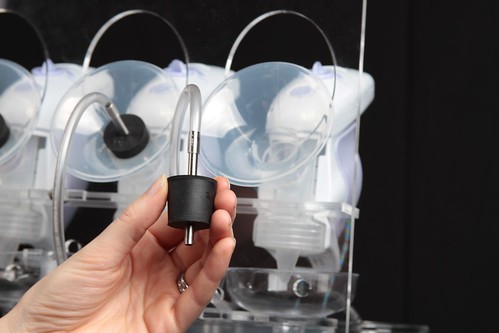
For input into the pump, we measured the cup size and determined that size 5.5 stoppers were the right ones. Stoppers are available pre-drilled, and we cut some carefully-sized stainless steel tubing to adapt to them. From there, Tygon “food and beverage” tubing goes down to carafes filled with our fluids.
These pumps are not designed to lift liquids over a large vertical distance, so we constructed a platform on which to support the carafes at a more comfortable height.
The silicone rubber valves at the bottoms of the pumps normally are fitted into baby bottles. We didn’t need the bottles, but rather funnels. We constructed some appropriately shaped funnels by cutting the stems of disposable plastic champagne glasses.
The three funnels below the pumps direct their fluids into this translucent trough, which is our ice bucket. At the lower right hand of the ice bucket, there is a hole drilled, where the contents can drip into a fourth cut-off champagne glass funnel, into a larger piece of Tygon tubing that becomes the spout where you put your glass.
Finally, the controller is based on a modified Meggy Jr RGB. In place of a speaker and the two right buttons, it now has three PNP transistors that control the three pumps. The 8×8 RGB display scrolls out “DRINK MAKING UNIT,” or other messages as needed.
For its maiden voyage (resisting the urge to use the word virgin, here), we configured the Drink-Making Unit to construct white russians.
Here is how it looks ready for action, with the fluids loaded into their carafes and ice loaded into the bucket:
After we push the button, the pump pulls the cream up the the tube from the carafe and squirts it out the valve below. (It’s nice and creepy looking.)
The cream lands on the ice, and then runs through the hole in the ice bucket to the champagne glass funnel below.
From the funnel, to the tube, to the glass:
And repeat for the Kahlua and vodka.
Again, we’ll be showing off our little Rube Goldberg drink mixer at Barbot 2010 and we invite you to stop by and try it out for yourself– hope to see you there.
You may also want to check out this youtube videothat we made while trying out the Drink Making Unit, so that you too can experience the process of having your drink made by a silly and inefficient cocktail robot. :)




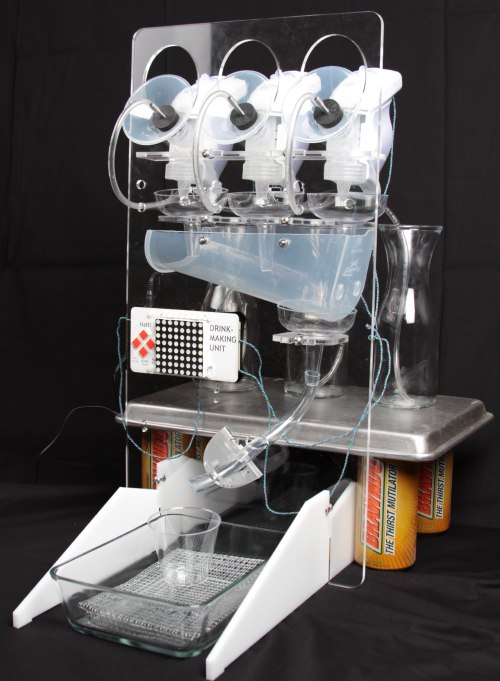
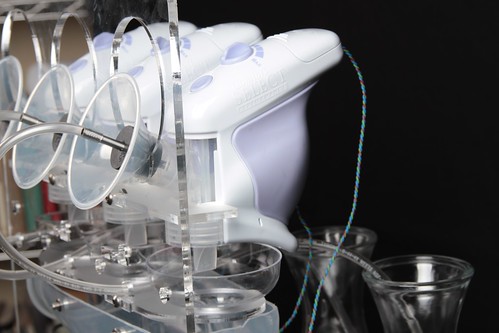
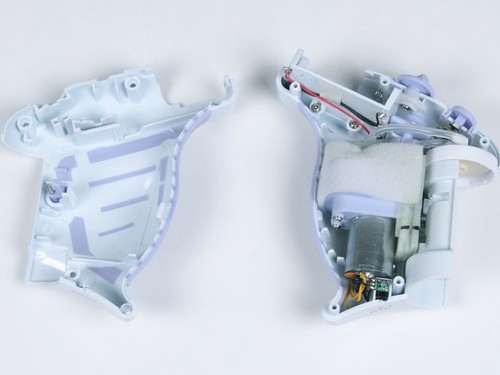
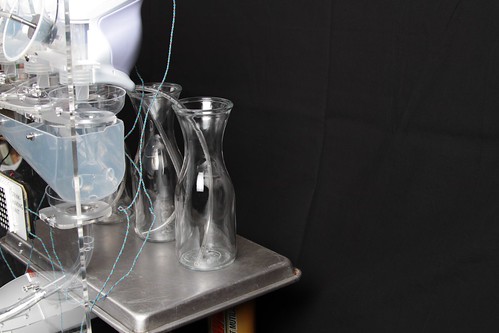
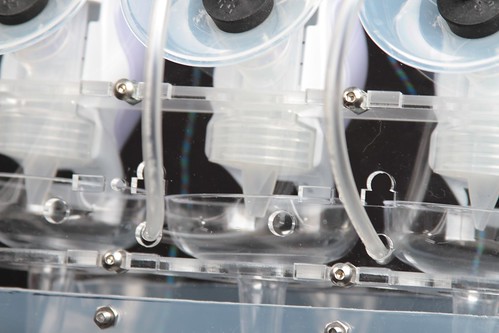
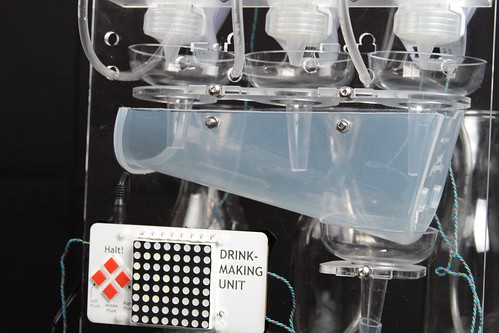
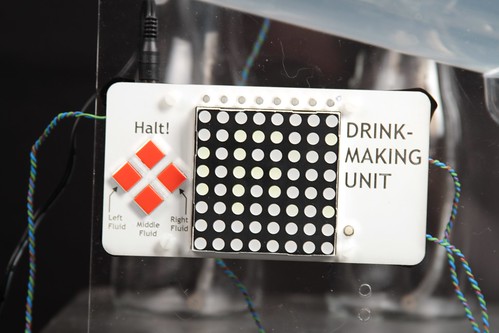
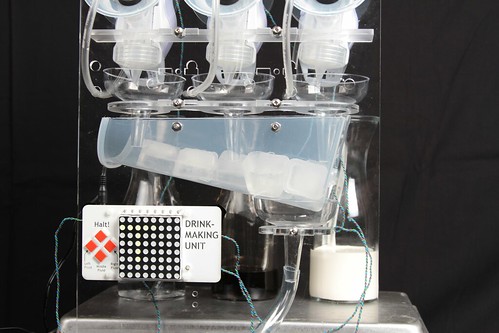
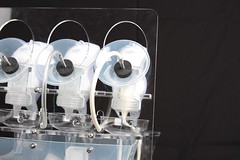
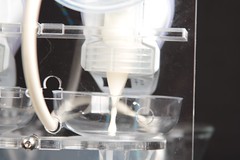
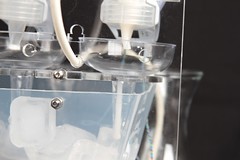
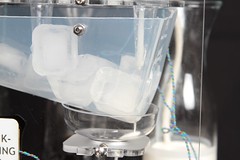
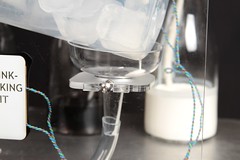
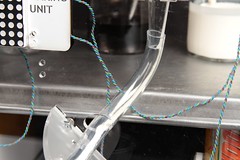
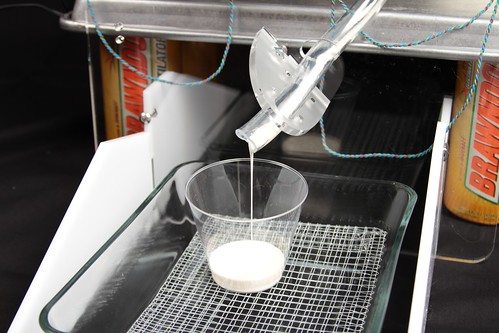
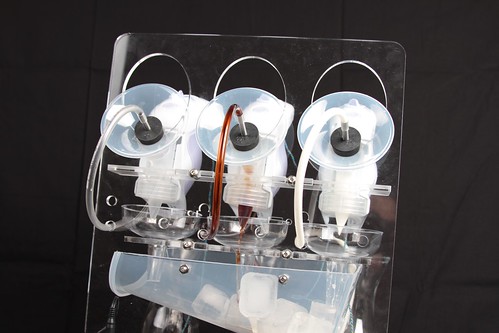
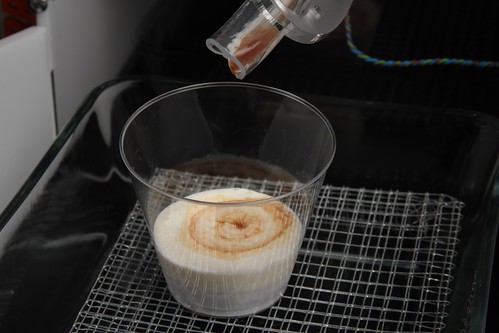
As I’m sure you’re aware, you have to go to Eroticon 6 or Mars for the three-pack.
So basically it looks like programming only refers to what appears on the Meggy Jr. The buttons are nothing more than over engineered on/off switches. Timing of the shot is by hitting the button a second time when you think you’ve poured enough. He added transistors to them for what reason I’m not sure since just an on/off switch with long wires are all that these buttons seem to function as. This might be impressive if you could actually select a drink, hit go and wait for your nectar of the gods to dispense.
Wait… Let me get this straight: You’re trying to insult our silly, super-inefficient, Rube Goldberg style drinkbot by saying that it’s "overengineered?" Are you kidding me? That’s the whole point!
(Oh, and yeah, it’s easy enough to put the buttons on a timer once we figure out the right settings for the different pumps. It’s programmable; we have good options.)
—
Windell H. Oskay
drwho(at)evilmadscientist.com
http://www.evilmadscientist.com/
Is it wrong that I’m imagining one unit of liquid per button-press? Three presses of the left button gives you three shots from the leftmost carafe??
The display is perfectly suited to showing a bar graph of the amount of fluid selected.
Dial up the right amount of booze from each container, and another button mixes it all up…
Well, just suppose, for instance, that there was only one button that would turn on the machine which would self select the three containers one after another. Then, perhaps a set of three, buttons that would adjust the liquids to perhaps: Sane, Slipping, and Way Over The Top! that way, one could select the strenght they desired.
I think the complaint is mostly directed at the current software/firmware, which is much less cool then realizing breast pumps are a pretty good way to move food safe liquid (which isn’t a small realization at all – I realized the same thing at one point after owning a breast pump for the more mundane task of emptying milk from a boob for later delivery to a baby). It’s certainly "problem solved" but it’d knock it out of the water further to have it do custom stuff on auto since it’s possible given the hardware (two parts carafe one easy on carafe three? no problem).
Very nice looking!
& a great article!
oh, wasn’t logged into my newly created account ;)
cheers,
magnus
Is there any chance that you can increase the speed? I like the thought of using these pumps, but they appear way too slow.
Yes, particularly for the thinner liquid. I don’t know if you saw in the video, but the shot of vodka poured in about 15 seconds once we turned it up. Also, we can run all three pumps at the same time and on separate timers, with separate PWM speed control, so we have a number of options to tune. :)
—
Windell H. Oskay
drwho(at)evilmadscientist.com
http://www.evilmadscientist.com/
I bet these come in 2s cause people only have 2 breasts. Clever marketing.
Great article, got me thinking.
Congratulations, and welcome to the sticky, messy, hard-to-clean world of cocktail robotics! Wish I could be there for barbot 2010.
If you had the source material in bottles like this coffee flavor, then invert the bottle, put tygon tubing on the spout, and have tubing-pincers as valves from the outside, you can skip the pumps.
That is, the active piece just needs to be able to pinch your tubing flat (much like a peristaltic pumps).
Parts touching food list:
Bottle, stopper, tygon.
The pure gravity feed is also likely to be quite a bit faster.
Yes, that’s a fairly common solution, and we’ve seen a number of barbots that use almost that exact design… which is exactly why we didn’t do it. There is one issue with that type, which is that most of the pinchers that I’ve seen fail open when they lose power.
They also have the same metering problem that our pumps do: the flow rate depends upon the liquid level. If we were to redo it from scratch, we’d surely go with peristaltic pumps.
—
Windell H. Oskay
drwho(at)evilmadscientist.com
http://www.evilmadscientist.com/
I love this design guys, really nice job. One question I have about cocktail robots in general — do any of them shake or stir the drinks with ice? As a mixological pedant, I fear that the robots will never match our skill level if they don’t do some significant mixing/emulsification, proper chilling, and dilution of water into the drink. I checked the Roboexotica site but couldn’t find a list of the bots that have attended, so maybe this has already entered into the realm of the more elaborate machines.
Thanks,
John
There are a number of robot pictures and descriptions on that site; I linked to one of them in the intro. Better yet is to look for the *videos* from the events– they really give a *much better* idea what the different things do. If there isn’t one that shakes and pours the martini shaker, I think it’s up to you to build it!
—
Windell H. Oskay
drwho(at)evilmadscientist.com
http://www.evilmadscientist.com/
Yes, I’m thinking I should build the secondary unit made from a paint can shaker that hooks up to your primary liquid dispensing unit!
Looks pretty professional, your version of the white russian hippie bot.
Congratulations!
fra, roboexotica.org
Now that I slept it over: White Russian is not the right drink for this machine. The machine does not look russian at all. You need some other type of recipe, maybe a Tequila sunrise will do?
For a machine using breast pumps, we think that it’s most apt if the drink involves either milk, cream, or irish cream– we’ve been looking at other options as well, including the brandy Alexander, a B-52, and the grasshopper.
—
Windell H. Oskay
drwho(at)evilmadscientist.com
http://www.evilmadscientist.com/
Interesting but in the time this thing made one drink, I could have already mixed my own and be done drinking it. It’s cool as a concept, but all it really does is instead of you from pouring the drinks out of a bottle and in to your glass, you’re pouring your drinks out of the bottle in to another bottle then toggling individual pumps on and off one at a time to syphon the drinks out of the second bottle and in to your glass.
It would be much better if you got to pick what drink you and the machine mixed it for you.
You seem to have figured out the general idea about cocktail robots; ours is a fairly simple member of this Rube Goldberg genre.
> It would be much better if you got to pick what drink you and the machine mixed it for you.
With our machine, you do get to pick what to drink, and the machine mixes it for you. Not sure what your point is. If you operate the fluids one at a time (like we did in the video) you get much finer grain control over the mixing than if you just push a button and it gets to pick.
—
Windell H. Oskay
drwho(at)evilmadscientist.com
http://www.evilmadscientist.com/
You should look into using automated blood pressure monitoring units for a tiny but very efficient pump. Not sure about edible aspect of it though.
Your choice of food-grade pumps really sucks.
:-)
(one wonders how many BarBot attendees would recognize these if you hadn’t told us all…)
Your basic setup should be able to deliver white russians, black russians, or straight vodka, all under SW control!
Watching people’s reactions as the either figured it out or we told them was *fantastic.* Probably about 20% of people recognized them or figured it out on their own. A far number beyond that had heard other people talking about it. We were also asked several times if they were autopipettors– those actually do look very similar. Just a few people were weirded out by the idea, but (so far as I can tell) that wasn’t enough to get between the and a white russian. :)
—
Windell H. Oskay
drwho(at)evilmadscientist.com
http://www.evilmadscientist.com/
The biggest problem I see is that the ice in your "ice bucket" is contaminated and needs to be changed after every drink. Additionally, running the booze through the ice will water it down. It might make more sense to run it through something like a distillation condenser, with an inner tube containing the flow surrounded by a coolant.
Just a thought.
>The biggest problem I see is that the ice in your "ice bucket" is contaminated and
>needs to be changed after every drink.
WTF? "Contaminated" by the same ingredients that are in the drink?
>Additionally, running the booze through the ice will water it down.
Only to a minimal extent; much like a martini shaker. This is specifically designed to keep dripping out between drinks so that there’s no accumulation of meltwater.
> It might make more sense to run it through something like a distillation condenser,
>with an inner tube containing the flow surrounded by a coolant.
No, it wouldn’t. THEN you’d have contamination like crazy– there’s absolutely no way to clean the inside of one of those things between drinks, particularly if there’s cream involved.
—
Windell H. Oskay
drwho(at)evilmadscientist.com
http://www.evilmadscientist.com/
> WTF? "Contaminated" by the same ingredients that are in the drink?
Yes – what if one person wants cream, and the next person doesn’t? (i.e. white russian followed by black russian)
Or are you assuming that everyone is drinking the same thing?
>Or are you assuming that everyone is drinking the same thing?
Yes, the scrolling message text says "TODAY I AM MAKING WHITE RUSSIANS" — and that’s all that it does.
Keeping the paths fully independent– for example if someone had a milk allergy — would require fully separate fluid paths, right down to separate nozzles to the cup; something precluded by the design of most barbots at our event.
—
Windell H. Oskay
drwho(at)evilmadscientist.com
http://www.evilmadscientist.com/
Sorry just my 2 cents if you ran three tubes through a bath of icy salt water you could cool the liquids without mixing them before the cup. obviously metal tubing would conduct better.
interesting, was just planning the same for our hackerspace.
what do you think about industrial air pressure valves? they are quite cheap to buy, should be very reliable. only issue i have is that i’m not sure if they loose oil into the air. that would be less desirable for a food bot.
Pressure could be taken from a small water carboator.
do you have links to air pressure based projects?
So how much does it cost? I might want one..
goodness gracious, what is with all the haters and squares up in here?
1) it makes white russians, so get your gold-bricking asses out of our beach-community thread.
2) it is sitting on brawndo cans, people. BRAWNDO. THE THIRST MUTILATOR.
sigh.
that is all.
Wow, do you think it makes your white russians taste like a monster truck you can pour into your face? Or like the feeling of crushing a human skull with your BARE HANDS!?
Ah this is a very nice project. I find the Breast pumps to be a unique choice. I have been looking for food grade pumps and your right they are not easy to find in a resonable price range and that can handle alcohol. You folks did a great job with your innovative ideas and eye for the available affordable solution. Will you be attending RoboGames?
Thanks!
>Will you be attending RoboGames?
Yes, although it’s not yet clear in what capacity we’ll be attending. :)
—
Windell H. Oskay
drwho(at)evilmadscientist.com
http://www.evilmadscientist.com/
I like it, very hip. use it to much and you will have to construct a bot that hosts AA meetings
This is really cool and i like it :) reminds me of a project i saw on the net years ago called bar monkey.
I did just try another option after reading this and it worked well.
I have one of them drink pouring caps u add to your liqueur that has a small ball bearing that when at an angle slides up and lets u pour a drink then when fully upright the ball moves down and blocks the liquid from pouring.
Well i just tried having a bottle of bourbon upside down with this cap and when i put a magnet neer the middle of the cap the ball bearing moved up and it poured out rather smoothly. So another option might be to have some bottles hanging upside down with tubes connected and then an electromagnet hooked up to pour the drinks this would make sure that you don’t have pumps with moving parts and it would make it faster to make a drink.
Just a thought if u ever made another version :)
I was thoroughly amused to come upon this while doing some breastmilk pumping. Now I know what to do with the parts when I’m done! :D
I’m curious, have you looked into using an air pump to pump air into an air tight container with an extra tube for the outlet to displace the liquid? I’m sure it’d be even more food safe than the current setup, and probably cheaper.
Yes, that’s one of the common methods, commonly referred to as a "wash bottle."
It works and is safe, but provides no means to measure the amount of liquid dispensed.
Windell H. Oskay
drwho(at)evilmadscientist.com
http://www.evilmadscientist.com/
Ah ok, so it flows differently with different levels of liquid? I guess one would have to develop something like a pivoting half or quarter ounce measure in the style of those japanese bamboo water fountains. Might not work well with thick enough liquids though, and the output would have to be diminished (my setup emptied 2L in about 90 seconds). Or maybe have a digital scale…
We also thought of the japanese fountain idea– I like that idea a lot. The scale would work too, but most methods don’t let you start and stop quickly– with a wash bottle you’d still want to go in little spurts so that you could stop quickly once you reached the correct weight.
Windell H. Oskay
drwho(at)evilmadscientist.com
http://www.evilmadscientist.com/
hello
i am from el salvador and i need mora information about the program lenguaje of the RGB matriz
and if only this information of this proyect be.